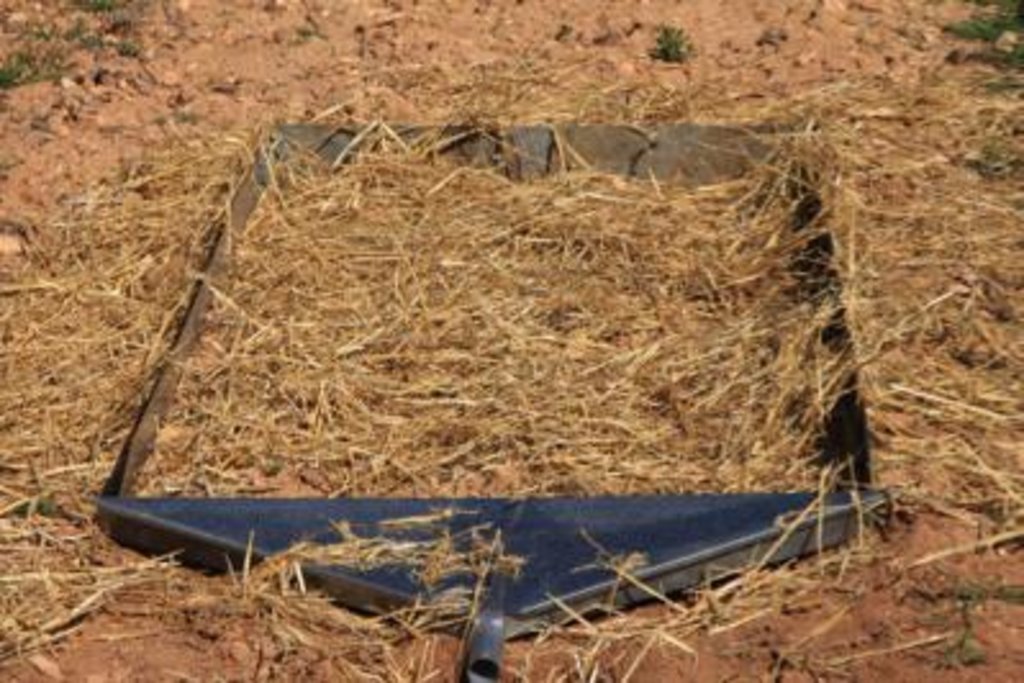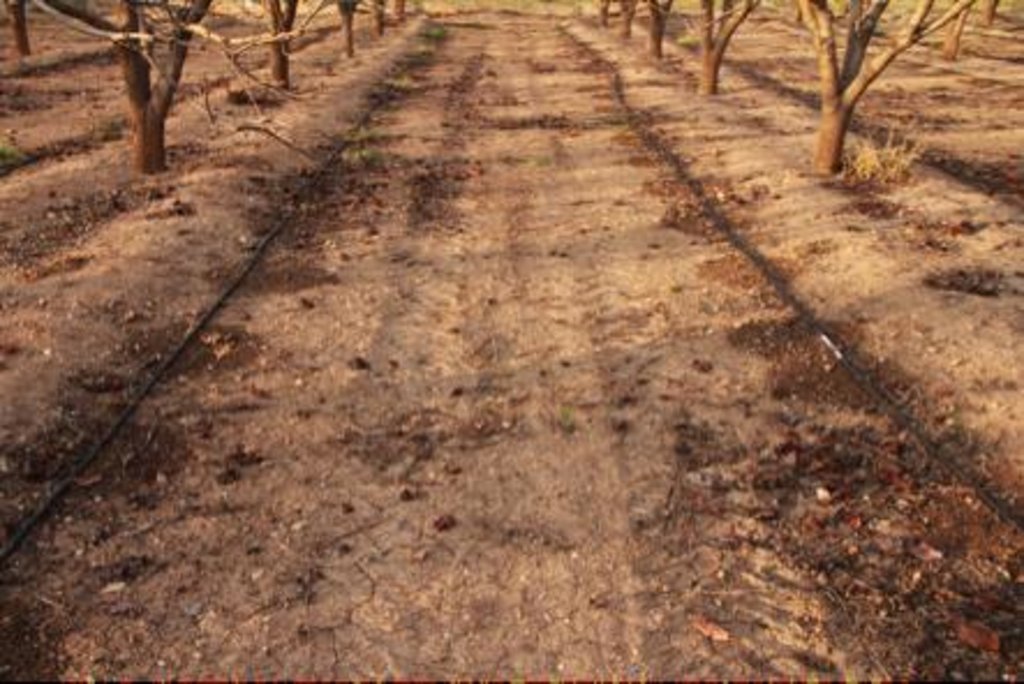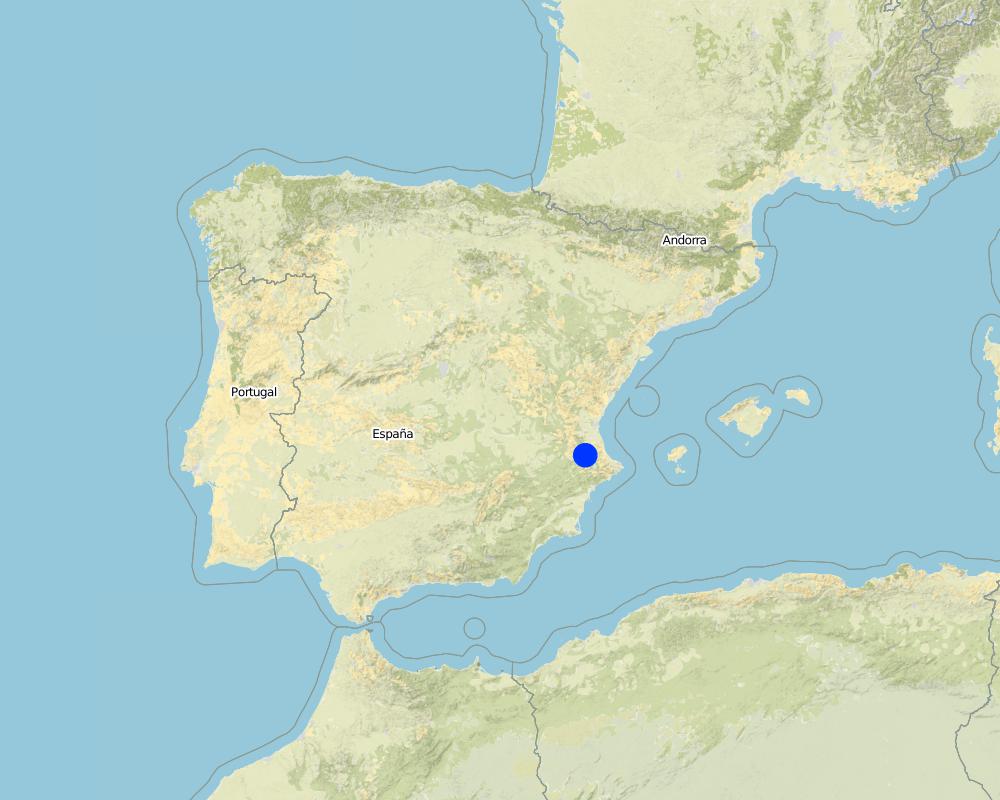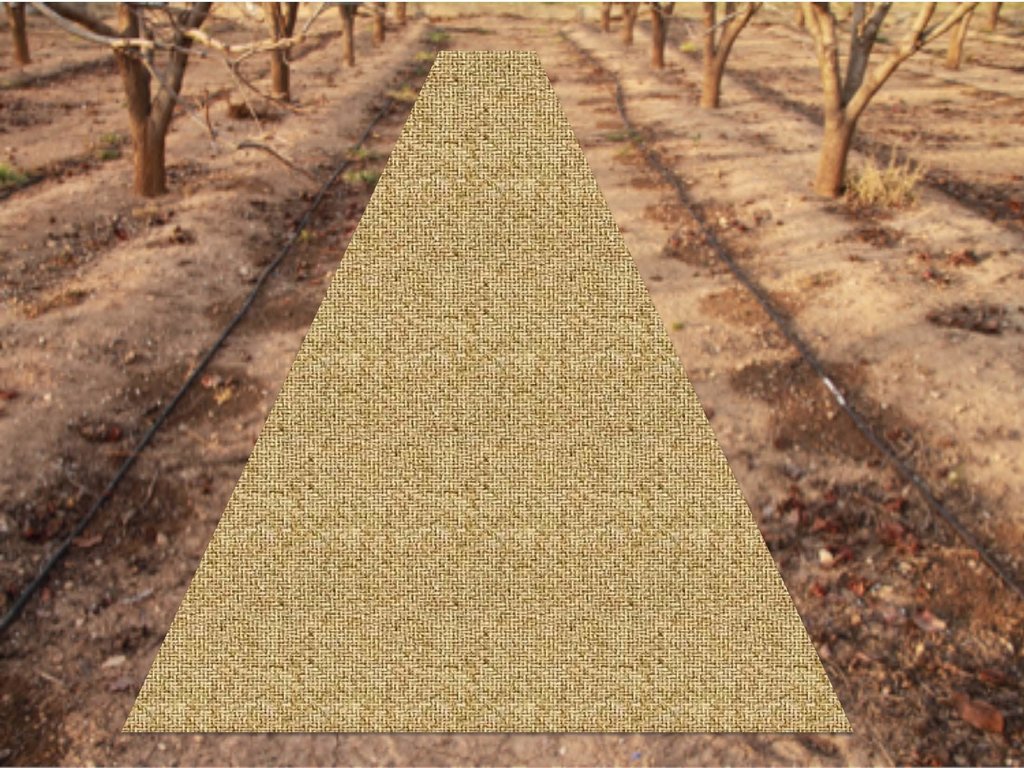Straw mulching to improve soil quality [Spain]
- Creation:
- Update:
- Compiler: Artemi Cerda
- Editor: –
- Reviewers: Fabian Ottiger, Deborah Niggli, Alexandra Gavilano
Efecto de la cubierta de paja en la calidad del suelo (spanish)
technologies_1255 - Spain
View sections
Expand all Collapse all1. General information
1.2 Contact details of resource persons and institutions involved in the assessment and documentation of the Technology
Name of the institution(s) which facilitated the documentation/ evaluation of the Technology (if relevant)
Universidad de Valencia (Universidad de Valencia) - Spain1.3 Conditions regarding the use of data documented through WOCAT
When were the data compiled (in the field)?
28/05/2015
The compiler and key resource person(s) accept the conditions regarding the use of data documented through WOCAT:
Yes
1.4 Declaration on sustainability of the described Technology
Is the Technology described here problematic with regard to land degradation, so that it cannot be declared a sustainable land management technology?
No
Comments:
It is a good way to restore land
2. Description of the SLM Technology
2.1 Short description of the Technology
Definition of the Technology:
Straw mulch application on bare soil in order to prevent soil erosion, reduce overland flow, and increase soil organic matter.
2.2 Detailed description of the Technology
Description:
In a persimmon crop area near Valencia (South-East Spain), the research team of the University of Valencia has set up an experiment in 2015 to test the effect of the straw mulch technique in order to avoid water erosion and improve soil properties. Straw mulch was applied at a rate of 75 g per m2 and spread over 40 erosion plots (20 treated/20 non-treated). Afterwards, rainfall simulations at 78 mm h-1 of I30 mimic a high-magnitude storm.
The straw provides an initial cover of 60%, and was found to reduce runoff from 60% (in non-treated plots) to 29% (in treated plots), and erosion from 5.1 Mg ha-1 to 0.2 Mg ha-1.
Purpose of the Technology: The increase in ground cover will decrease soil erosion by reducing raindrop impact over the bare soil. Runoff also decreases by increasing water surface storage, decrease of runoff velocity, and increase infiltration.
Its application must to be done before high-storm events in the Mediterranean; namely end of summer to early autumn, in order to protect raindrop impact and avoid detachment of bare soil.
Establishment / maintenance activities and inputs: The straw mulch was delivered from a nearby farm in straw bales and was manually applied to the research plots.
Natural / human environment: The wine production in the area was implemented by old civilizations. Nowadays, vineyards production is spread over the entire study area, together with new plantations of persimmon, apricots, olives and oranges. The landscape reflects the long history of management where several constructions related with wine production depicted its importance on this region. Since the late 1960s, conventional agriculture with fertilizers and herbicides has led to a seasonally bare soil surface, triggering huge erosion rates.
2.3 Photos of the Technology
2.5 Country/ region/ locations where the Technology has been applied and which are covered by this assessment
Country:
Spain
Region/ State/ Province:
Spain
Further specification of location:
Valencia district
Comments:
Specify the spread of the Technology:
evenly spread over an area
If the Technology is evenly spread over an area, indicate approximate area covered:
< 0.1 km2 (10 ha)
Map
×2.6 Date of implementation
If precise year is not known, indicate approximate date:
- less than 10 years ago (recently)
2.7 Introduction of the Technology
Specify how the Technology was introduced:
- during experiments/ research
- through projects/ external interventions
3. Classification of the SLM Technology
3.1 Main purpose(s) of the Technology
- reduce, prevent, restore land degradation
3.2 Current land use type(s) where the Technology is applied

Forest/ woodlands
Products and services:
- Fruits and nuts
- Other forest products
- grapes, persimmon, apricots, olives and oranges

Unproductive land
Specify:
shrub vegetation: quercus ilex, quercus coccifera, pistacia lentiscus, rosmarinus officinalis; Grass species: brachypodium retusum
Comments:
Major land use problems (compiler’s opinion): Increased runoff and soil erosion, resulting in a decrease of on-site fertility, water reservoir, and weakness of hydrological soil properties.
Major land use problems (land users’ perception): Loss of water-soil resources and productivity.
If land use has changed due to the implementation of the Technology, indicate land use before implementation of the Technology:
The landscape reflects the long history of management where several constructions related with wine production depicted its importance on this region. Since the late 1960s, conventional agriculture with fertilizers and herbicides has led to a seasonally bare soil surface, triggering huge erosion rates.
Change of land use practices / intensity level: yes, change due to diminish herbicides application, and minimize bare soil exposition.
3.3 Further information about land use
Water supply for the land on which the Technology is applied:
- rainfed
Number of growing seasons per year:
- 1
Specify:
Longest growing period in days: 180, Longest growing period from month to month: February to July
3.4 SLM group to which the Technology belongs
- improved ground/ vegetation cover
3.5 Spread of the Technology
Specify the spread of the Technology:
- evenly spread over an area
If the Technology is evenly spread over an area, indicate approximate area covered:
- < 0.1 km2 (10 ha)
3.6 SLM measures comprising the Technology

agronomic measures
- A1: Vegetation/ soil cover

vegetative measures
- V1: Tree and shrub cover

management measures
- M2: Change of management/ intensity level
Comments:
Type of agronomic measures: mulching
3.7 Main types of land degradation addressed by the Technology

soil erosion by water
- Wt: loss of topsoil/ surface erosion

physical soil deterioration
- Pk: slaking and crusting

biological degradation
- Bc: reduction of vegetation cover

water degradation
Comments:
Causes of degradation: soil management, crop management (annual, perennial, tree/shrub), over-exploitation of vegetation for domestic use, disturbance of water cycle (infiltration / runoff), Heavy / extreme rainfall (intensity/amounts)
3.8 Prevention, reduction, or restoration of land degradation
Specify the goal of the Technology with regard to land degradation:
- reduce land degradation
4. Technical specifications, implementation activities, inputs, and costs
4.1 Technical drawing of the Technology
4.2 Technical specifications/ explanations of technical drawing
Straw mulch must be spread homogeneously in bare soil areas between trees lines in order to keep as much as possible the soil covered.
Location: Canals. Valencia, Spain
Technical knowledge required for field staff / advisors: low (It is easy to implement)
Technical knowledge required for land users: low
Secondary technical functions: control of raindrop splash, control of dispersed runoff: retain / trap, control of dispersed runoff: impede / retard, control of concentrated runoff: retain / trap, control of concentrated runoff: impede / retard, control of concentrated runoff: drain / divert, improvement of ground cover, increase of surface roughness, improvement of topsoil structure (compaction), increase in organic matter, increase in nutrient availability (supply, recycling,…), increase of infiltration, increase / maintain water stored in soil, improvement of water quality, buffering / filtering water, sediment retention / trapping, sediment harvesting, increase of biomass (quantity), promotion of vegetation species and varieties (quality, eg palatable fodder)
Mulching
Material/ species: SPRING BARLEY
Quantity/ density: 75g/m2
Slope (which determines the spacing indicated above): 2%
Change of land use practices / intensity level: yes, change due to diminish herbicides application, and minimize bare soil exposition.
4.3 General information regarding the calculation of inputs and costs
Specify how costs and inputs were calculated:
- per Technology unit
Specify unit:
ha
Specify currency used for cost calculations:
- US Dollars
Indicate exchange rate from USD to local currency (if relevant): 1 USD =:
800.0
Indicate average wage cost of hired labour per day:
80
4.4 Establishment activities
| Activity | Type of measure | Timing | |
|---|---|---|---|
| 1. | Apply straw mulch (75g/m) | Agronomic | summer |
4.5 Costs and inputs needed for establishment
| Specify input | Unit | Quantity | Costs per Unit | Total costs per input | % of costs borne by land users | |
|---|---|---|---|---|---|---|
| Labour | Straw | Kg | 1000.0 | 100.0 |
4.8 Most important factors affecting the costs
Describe the most determinate factors affecting the costs:
The price of straw varies, depending on the quality. Transport and application will increase the cost.
5. Natural and human environment
5.1 Climate
Annual rainfall
- < 250 mm
- 251-500 mm
- 501-750 mm
- 751-1,000 mm
- 1,001-1,500 mm
- 1,501-2,000 mm
- 2,001-3,000 mm
- 3,001-4,000 mm
- > 4,000 mm
Specifications/ comments on rainfall:
Dry spells of 3 months (june, august, september)
Other rainfall annual averages are 250-500mm (ranked 2) or >250mm or 750-1000 mm (both ranked 3)
Agro-climatic zone
- sub-humid
- semi-arid
Thermal climate class: temperate
5.2 Topography
Slopes on average:
- flat (0-2%)
- gentle (3-5%)
- moderate (6-10%)
- rolling (11-15%)
- hilly (16-30%)
- steep (31-60%)
- very steep (>60%)
Landforms:
- plateau/plains
- ridges
- mountain slopes
- hill slopes
- footslopes
- valley floors
Altitudinal zone:
- 0-100 m a.s.l.
- 101-500 m a.s.l.
- 501-1,000 m a.s.l.
- 1,001-1,500 m a.s.l.
- 1,501-2,000 m a.s.l.
- 2,001-2,500 m a.s.l.
- 2,501-3,000 m a.s.l.
- 3,001-4,000 m a.s.l.
- > 4,000 m a.s.l.
Indicate if the Technology is specifically applied in:
- not relevant
5.3 Soils
Soil depth on average:
- very shallow (0-20 cm)
- shallow (21-50 cm)
- moderately deep (51-80 cm)
- deep (81-120 cm)
- very deep (> 120 cm)
Soil texture (topsoil):
- medium (loamy, silty)
Topsoil organic matter:
- medium (1-3%)
If available, attach full soil description or specify the available information, e.g. soil type, soil PH/ acidity, Cation Exchange Capacity, nitrogen, salinity etc.
Soil fertility is medium
Soil drainage/infiltration is medium
Soil water storage capacity is medium
5.4 Water availability and quality
Ground water table:
5-50 m
Water quality (untreated):
for agricultural use only (irrigation)
Is water salinity a problem?
No
Is flooding of the area occurring?
No
Comments and further specifications on water quality and quantity:
Availability of surface water: excess, poor/ none (surface water is only available when rains. Heavy rains produce overland flow)
5.5 Biodiversity
Species diversity:
- low
Comments and further specifications on biodiversity:
Only trees on cultivations and anual herbs and grasses.
5.6 Characteristics of land users applying the Technology
Sedentary or nomadic:
- Sedentary
Market orientation of production system:
- commercial/ market
Off-farm income:
- less than 10% of all income
Relative level of wealth:
- average
Individuals or groups:
- individual/ household
Level of mechanization:
- manual work
Gender:
- men
Age of land users:
- middle-aged
5.7 Average area of land owned or leased by land users applying the Technology
- < 0.5 ha
- 0.5-1 ha
- 1-2 ha
- 2-5 ha
- 5-15 ha
- 15-50 ha
- 50-100 ha
- 100-500 ha
- 500-1,000 ha
- 1,000-10,000 ha
- > 10,000 ha
Is this considered small-, medium- or large-scale (referring to local context)?
- medium-scale
5.8 Land ownership, land use rights, and water use rights
Land ownership:
- individual, titled
Land use rights:
- individual
Water use rights:
- individual
5.9 Access to services and infrastructure
health:
- poor
- moderate
- good
education:
- poor
- moderate
- good
technical assistance:
- poor
- moderate
- good
employment (e.g. off-farm):
- poor
- moderate
- good
markets:
- poor
- moderate
- good
energy:
- poor
- moderate
- good
roads and transport:
- poor
- moderate
- good
drinking water and sanitation:
- poor
- moderate
- good
financial services:
- poor
- moderate
- good
6. Impacts and concluding statements
6.1 On-site impacts the Technology has shown
Socio-economic impacts
Production
crop production
fodder production
fodder quality
animal production
wood production
risk of production failure
product diversity
production area
land management
Water availability and quality
demand for irrigation water
Income and costs
expenses on agricultural inputs
farm income
economic disparities
workload
Ecological impacts
Water cycle/ runoff
water quantity
water quality
surface runoff
excess water drainage
groundwater table/ aquifer
evaporation
Soil
soil moisture
soil cover
soil crusting/ sealing
soil compaction
salinity
soil organic matter/ below ground C
Biodiversity: vegetation, animals
pest/ disease control
Climate and disaster risk reduction
fire risk
wind velocity
6.2 Off-site impacts the Technology has shown
water availability
reliable and stable stream flows in dry season
downstream flooding
downstream siltation
groundwater/ river pollution
buffering/ filtering capacity
wind transported sediments
damage on neighbours' fields
damage on public/ private infrastructure
impact of greenhouse gases
6.3 Exposure and sensitivity of the Technology to gradual climate change and climate-related extremes/ disasters (as perceived by land users)
Gradual climate change
Gradual climate change
| Season | Type of climatic change/ extreme | How does the Technology cope with it? | |
|---|---|---|---|
| annual temperature | increase | not well |
Climate-related extremes (disasters)
Meteorological disasters
| How does the Technology cope with it? | |
|---|---|
| local rainstorm | well |
| local windstorm | not well |
Climatological disasters
| How does the Technology cope with it? | |
|---|---|
| drought | well |
Hydrological disasters
| How does the Technology cope with it? | |
|---|---|
| general (river) flood | not known |
Other climate-related consequences
Other climate-related consequences
| How does the Technology cope with it? | |
|---|---|
| reduced growing period | not known |
6.4 Cost-benefit analysis
How do the benefits compare with the establishment costs (from land users’ perspective)?
Short-term returns:
neutral/ balanced
Long-term returns:
neutral/ balanced
How do the benefits compare with the maintenance/ recurrent costs (from land users' perspective)?
Short-term returns:
neutral/ balanced
Long-term returns:
neutral/ balanced
Comments:
Mulch is seen as an expensive treatment without any advantage.
6.5 Adoption of the Technology
- single cases/ experimental
Of all those who have adopted the Technology, how many have did so spontaneously, i.e. without receiving any material incentives/ payments?
- 0-10%
Comments:
Comments on adoption trend: The owners are not aware because of the costs, but they will change if the government start funding it.
6.6 Adaptation
Has the Technology been modified recently to adapt to changing conditions?
No
6.7 Strengths/ advantages/ opportunities of the Technology
| Strengths/ advantages/ opportunities in the land user’s view |
|---|
| It will prevent soil losses and promotes soil organic matter incorporation. High levels of soil moisture will prevent for drought periods. |
| Strengths/ advantages/ opportunities in the compiler’s or other key resource person’s view |
|---|
| It is a technology very easy to apply, with low failure possibilities and a strong soil erosion control and local soil properties improvement. |
6.8 Weaknesses/ disadvantages/ risks of the Technology and ways of overcoming them
| Weaknesses/ disadvantages/ risks in the land user’s view | How can they be overcome? |
|---|---|
| The costs are not very high, but enough to discourage the landowners to cover the expenses. | Look for Government funding. |
| Weaknesses/ disadvantages/ risks in the compiler’s or other key resource person’s view | How can they be overcome? |
|---|---|
| When applying high-density mulches the application labours will be higher. High decomposition rate. | Distribute the mulch in strips, and try to reduce the application rate. |
7. References and links
7.1 Methods/ sources of information
- field visits, field surveys
- interviews with land users
Links and modules
Expand all Collapse allLinks
No links
Modules
No modules






